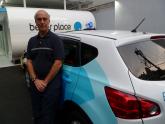Seeds of a Revolution - Electric Transport Triumphs in Tokyo

VIEW THE VIDEO TIED TO THIS STORY.
TOKYO - Several blocks from the emperor's palace, three gleaming taxis quietly slip down a side street several times a day. They glide up a track, stop, and wait as robotic equipment in an adjacent garage snaps into action. In 52 seconds, the battery depleted of electric charge is removed, a fully-charged replacement is installed and the driver is on his way.
The test by the Israeli energy company, Better Place, could well launch a revolution in transportation with huge ramifications the world over. Electric vehicles will soon be coming to showrooms in North America. The leading consumer concern that may limit their adoption is "range anxiety," a fear that the automobile will die en route to a destination. Better Place is out to conquer that anxiety.
Some skeptics wonder if the potential of the Better Place strategy will be limited by the reluctance of auto manufacturers to develop similar battery designs as they roll out electric vehicles.
The company says it is in discussions with major global automakers. Meanwhile, it has pioneered the infrastructure that will enable motorists to easily replace depleted batteries in less time than it takes to fill an empty gas tank. The initial test of the technology in Tokyo, the first such effort in the world, ended successfully the end of July and has been extended to the end of the year. A more extensive deployment is planned for Israel in 2011, and efforts are underway for launches in China, Denmark and elsewhere.
The investment world is paying attention. The company received an infusion of $350 million of equity from an HSBC-led consortium earlier this year. Anthony Bernbaum, global head of special opportunities for HSBC, said, "It could be a game-changer in its sector the way Google and Microsoft were in theirs."
I dropped in on the Better Place Tokyo facility late one summer day to discuss the project and its implications with Masamune Mimura, vice president and business development director, Better Place Japan.
Better Place worked with Nissan designing the electric-powered taxis. The 400-volt batteries, weighing about 550 pounds, are secured to the underside of each vehicle with bolt technologies developed by the Israelis to secure armaments to aircrafts. They are on the road from 8 a.m. to 1:30 a.m.
Rick Nicholson, vice president of IDC Energy Insights, visited the Tokyo installation and then blogged, "Better Place may have found a sweet spot in large urban taxi fleets." Nicholson, who is IT chair of the Knowledge2010 summit produced by Energy Central, focused on the IT side of the business. What impressed him, he wrote, is that "IT systems remotely monitor the location and status of the taxis including multiple variables related to the batteries and car components."
Japanese electric power leaders believe their robust grid can shoulder a surge in demand created by a growing electric vehicle fleet. The grid is considerably more advanced technologically than the North American grid. Japan average outages of about 19 minutes a year, compared to 97 minutes in the United States, industry figures show.
As Mimura reflected on the Better Place Tokyo project, the white-gloved driver of his taxi peered over the i-Pod on his dash that monitors his battery status as his car silently glided into traffic.
Mimura reports there are 60,000 taxis in Tokyo - the largest fleet of any urban center in the world. Collectively, they guzzle more than $600 million in gas a year. Better Place has already calculated that it would take 200 battery changing stations across Tokyo each capable of handling 300 cars a day to convert all of the city's taxis to electric power. Such a change out would be expensive, with each station requiring an investment of about $500,000 for equipment and $300,000 for the building, Mimura said. However, that compares favorably with a cost of about $1 million for a conventional gas station in Tokyo, he said.
The benefit? While taxis represent about 2 percent of the vehicles in Tokyo they are constantly on the road and therefore generate about 20 percent of the carbon emissions of all the vehicles in the city. If the taxis are electric powered instead of fueled by gas, it would make a significant dent in the city's carbon footprint, Mimura said.
Martin Rosenberg is editor-in-chief of EnergyBiz magazine.
To subscribe or visit go to: http://www.energybiz.com